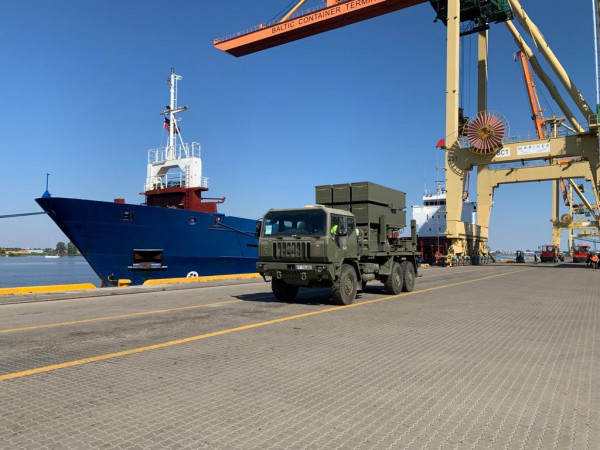Latvia's request to NATO: from the first second and the first meter
For Spain itself, hosting NATO leaders in Madrid today and tomorrow, it was also important to send the message that it fully supports the Alliance's intention to significantly reinforce the defense of the bloc's eastern flank. That is why the Spanish-owned NASAMS surface-to-air missile battery is deployed at the Lielvārde military base. A joint decision by NATO member states to shift from a relatively peaceful deterrence strategy to an active defense strategy must now follow. The aggressor must also not be allowed into the NATO buffer zone, which is us.
Against the backdrop of increased Russian aggression, the decisions taken today and tomorrow at the NATO meeting can play a decisive role in Latvia's security. Will what the alliance eventually allocates to the defense of the eastern flank be exactly what the Baltics and Poland are waiting for? Could NATO act even faster, smarter, more effectively? The recent warning by Estonian Prime Minister Kaja Kallas that NATO is about to condemn the Baltics to 180 days of devastating warfare at the hour of crisis - to first surrender it to the aggressor and then to retake - raises fears that decisions that are not effective or are even bad from the point of view of the interests of the Baltic States are being prepared for approval in Madrid. Just as the NATO powers are helping Ukraine - with huge moral and humanitarian support, but microscopic military support. However, Latvian top officials, going into the big meeting, seem to be more optimistic in words than their Estonian counterparts.
More and stronger
In a statement on the President's website, Egils Levits' quote in the headline is expressed in terms of need: "The new NATO Strategic Concept must confirm the commitment to deter and defend against the threat of the Russian Federation", but this has already become phrased as reality in the text below: "On June 29-30, President Egils Levits will attend the NATO Summit in Madrid, where a new NATO Strategic Concept and other documents and decisions will be adopted that clearly confirm NATO's commitment to deter and defend against the threat of the Russian Federation." So also to defend, and this wording has a huge meaning in military terminology, because deterrence is passive and defense is active. How this new model of defense will play out in practice was announced by NATO's chief spokesman, Secretary General Jens Stoltenberg, the day before the big meeting:
"At the Summit, we will strengthen our forward defences.
We will enhance our battlegroups in the eastern part of the Alliance up to brigade-levels. We will transform the NATO Response Force. And increase the number of our high readiness forces. To well over 300,000. We will also boost our ability to reinforce in crisis and conflict.
Including with: more pre-positioned equipment, and stockpiles of military supplies; more forward-deployed capabilities, like air defence; strengthened command and control; and upgraded defence plans, with forces pre-assigned to defend specific Allies." Stoltenberg's statement can be read in full HERE.
For maximum perimeter defense
What this and other forthcoming NATO statements say directly and what they say between the lines is for military analysts to judge, but the word from the political backrooms is that there is no more fighting about the Baltic security solution and all sides are half satisfied that the eastern flank will now be better protected and, hopefully, from the first meter. As Foreign Minister Edgars Rinkēvičs said on social media, "The basic task is to ensure the full perimeter defense of NATO and its member state (Latvia) to the maximum extent possible, preventing the enemy from entering NATO territory."

And together with other NATO member states, this is already being worked on. A military airfield has been built in Lielvārde, Latvia, which can be used by military aircraft of all kinds, such as the American MC-130J Commando II military aircraft that already flew from Germany to Riga for a demonstration, and to deploy the HIMARS missile artillery system, should the need arise. In addition, the Spanish-owned NASAMS surface-to-air missile battery with a crew of 85 men is now permanently stationed at the Lielvārde base. Aware of the potential threat, they have volunteered to come to Latvia. We have already reported that "Outsourcing air defense to NATO is a crisis solution".
We have received what we asked for
Neatkarīgā once again contacted Major Modris Kairišs, Commander of the NAF Air Force Training Centre. Asked to comment on the latest Spanish contribution to Latvia's defense, he confirms that we have received what we asked for. Moreover, the time since the decision was taken and implemented was relatively short - less than two weeks. Of course, the exact number of missiles, launchers, radars and sensors received has not been disclosed, but it is clear that Latvia now has at least some sort of permanent umbrella against Russian missiles and helicopters.
The decisions taken today and tomorrow at the NATO meeting in Madrid, as well as the defense plans that follow from them, must be such that Latvia and the other countries on NATO's eastern flank are as safe as possible from a Russian attack. Both in the sky and on the ground - and Riga no worse than Paris, Berlin, Washington or Madrid.